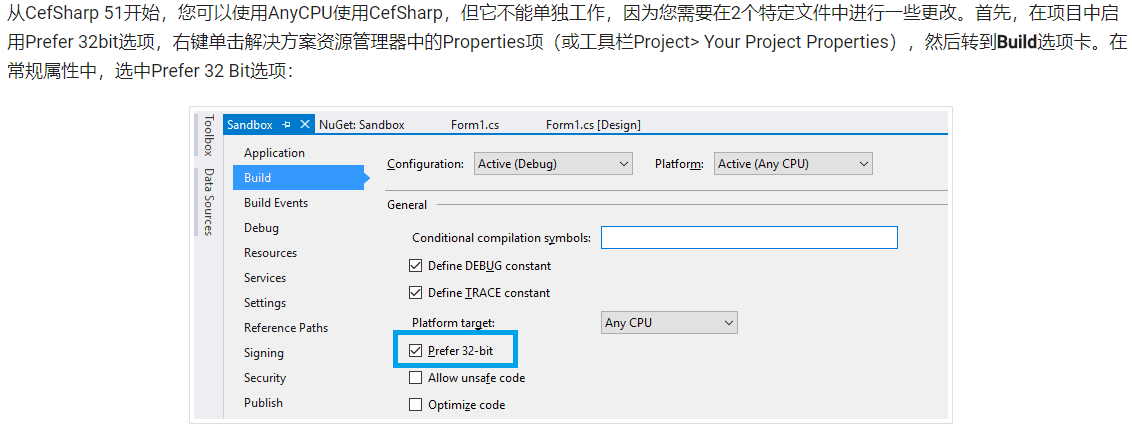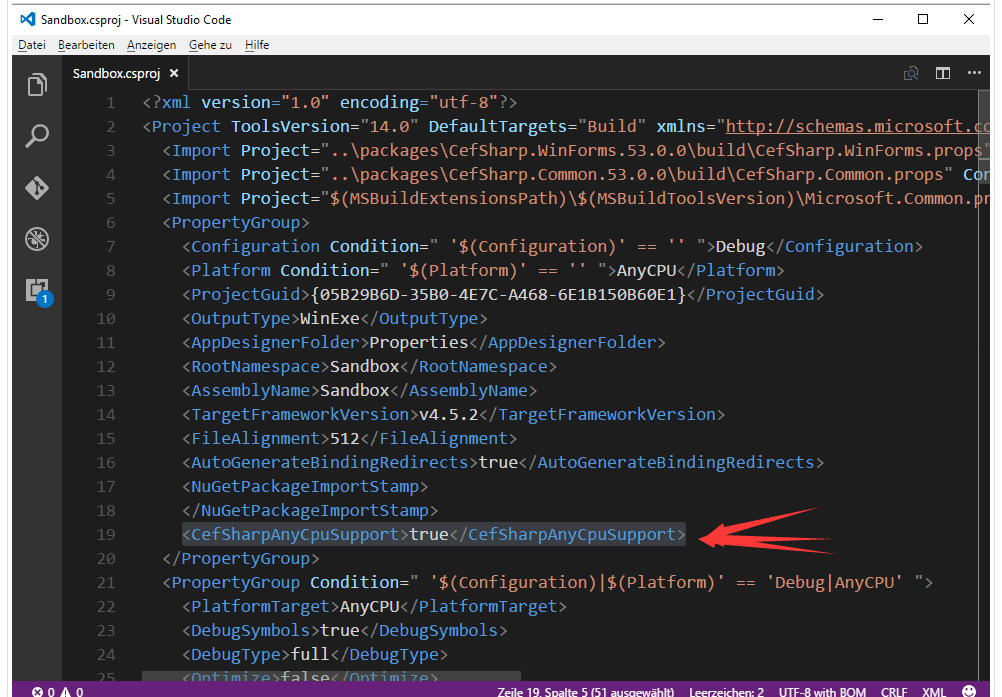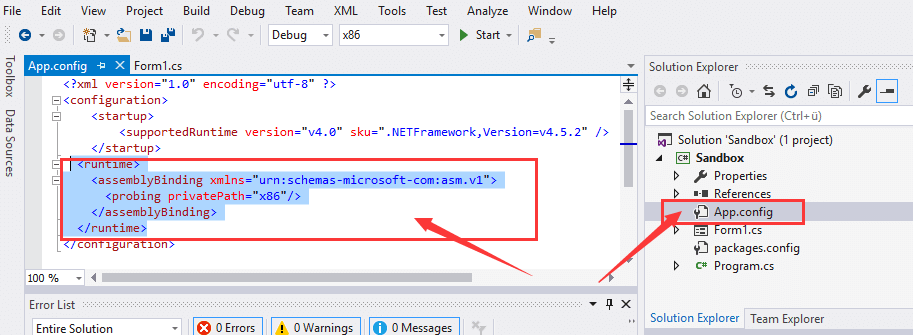转:C#:在AnyCPU模式下使用CefSharp
作者:互联网
------------吾亦无他,唯手熟尔,谦卑若愚,好学若饥-------------
本篇博客讲述如何在AnyCPU模式下使用CefSharp
因为在某些情况下,不得不用AnyCPU,但是CefSharp支持的是86和64位俩种模式,所以在我查阅了很多国内外的资料下,总结出来的一些精华
参考地址:
https://ourcodeworld.com/articles/read/173/how-to-use-cefsharp-chromium-embedded-framework-csharp-in-a-winforms-application
https://github.com/cefsharp/CefSharp/issues/1714
https://github.com/cefsharp/CefSharp.MinimalExample/blob/demo/anycpu/CefSharp.MinimalExample.Wpf/App.xaml.cs
三篇结合就可以实现在AnyCPU下使用CefSharp
简单步骤记录
第一篇博客取其第二个,更改配置的那一块,这块不改,下面的没用,项目起不起来
简述一下:
1.修改为首选32位,

2.在你项目名.csproj文件下,加一段
<CefSharpAnyCpuSupport>true</CefSharpAnyCpuSupport>
位置如下:

3.在App.config下加一端
<runtime>
<assemblyBinding xmlns="urn:schemas-microsoft-com:asm.v1">
<probing privatePath="x86"/>
</assemblyBinding>
</runtime>
位置如下:

第二篇博客取的精髓在这块,我给放过来
public partial class App : Application
{
public App()
{
//Add Custom assembly resolver
AppDomain.CurrentDomain.AssemblyResolve += Resolver;
//Any CefSharp references have to be in another method with NonInlining
// attribute so the assembly rolver has time to do it's thing.
InitializeCefSharp();
}
[MethodImpl(MethodImplOptions.NoInlining)]
private static void InitializeCefSharp()
{
var settings = new CefSettings();
// Set BrowserSubProcessPath based on app bitness at runtime
settings.BrowserSubprocessPath = Path.Combine(AppDomain.CurrentDomain.SetupInformation.ApplicationBase,
Environment.Is64BitProcess ? "x64" : "x86",
"CefSharp.BrowserSubprocess.exe");
// Make sure you set performDependencyCheck false
Cef.Initialize(settings, performDependencyCheck: false, browserProcessHandler: null);
}
// Will attempt to load missing assembly from either x86 or x64 subdir
// Required by CefSharp to load the unmanaged dependencies when running using AnyCPU
private static Assembly Resolver(object sender, ResolveEventArgs args)
{
if (args.Name.StartsWith("CefSharp"))
{
string assemblyName = args.Name.Split(new[] { ',' }, 2)[0] + ".dll";
string archSpecificPath = Path.Combine(AppDomain.CurrentDomain.SetupInformation.ApplicationBase,
Environment.Is64BitProcess ? "x64" : "x86",
assemblyName);
return File.Exists(archSpecificPath)
? Assembly.LoadFile(archSpecificPath)
: null;
}
return null;
}
}
第三篇博客 就是告诉你using指令怎么引,以及详细的写法,要用的话,还是用第二篇博客的这段代码
using System;
using System.IO;
using System.Reflection;
using System.Runtime.CompilerServices;
using System.Windows;
namespace CefSharp.MinimalExample.Wpf
{
public partial class App : Application
{
public App()
{
//Add Custom assembly resolver
AppDomain.CurrentDomain.AssemblyResolve += Resolver;
//Any CefSharp references have to be in another method with NonInlining
// attribute so the assembly rolver has time to do it's thing.
InitializeCefSharp();
}
[MethodImpl(MethodImplOptions.NoInlining)]
private static void InitializeCefSharp()
{
//Perform dependency check to make sure all relevant resources are in our output directory.
var settings = new CefSettings();
settings.BrowserSubprocessPath = Path.Combine(AppDomain.CurrentDomain.SetupInformation.ApplicationBase,
Environment.Is64BitProcess ? "x64" : "x86",
"CefSharp.BrowserSubprocess.exe");
Cef.Initialize(settings, performDependencyCheck: false, browserProcessHandler:null);
}
// Will attempt to load missing assembly from either x86 or x64 subdir
// Required by CefSharp to load the unmanaged dependencies when running using AnyCPU
private static Assembly Resolver(object sender, ResolveEventArgs args)
{
if (args.Name.StartsWith("CefSharp"))
{
string assemblyName = args.Name.Split(new[] { ',' }, 2)[0] + ".dll";
string archSpecificPath = Path.Combine(AppDomain.CurrentDomain.SetupInformation.ApplicationBase,
Environment.Is64BitProcess ? "x64" : "x86",
assemblyName);
return File.Exists(archSpecificPath)
? Assembly.LoadFile(archSpecificPath)
: null;
}
return null;
}
}
}
三套组合拳打完,CefSharp就可以在AnyCPU模式下使用了
标签:AnyCPU,assembly,settings,C#,CefSharp,CurrentDomain,using 来源: https://www.cnblogs.com/jakl/p/12222372.html